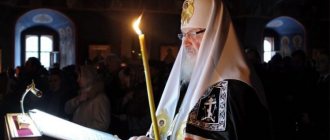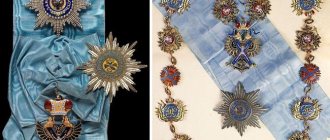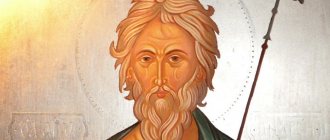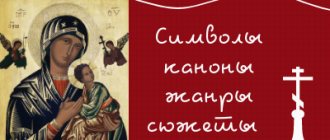Updated July 23, 2021
Hello, dear readers of the KtoNaNovenkogo.ru blog. It would seem that there is nothing intriguing: we learned what a “canon” is from a young age, when we rubbed our elbows on the lid of a school desk and broke our teeth, crushing the stubborn monoliths of science into marble chips.
But did you know that this word – “kanon” – is rooted in such historical depths that even recognized linguistic mastodons find it difficult to name its age?
However, we can limit ourselves to stating that this term has a centuries-old and very interesting history.
Canon is...
Its origin is associated with the West Semitic “qānoeh/ḳānu”, which translated means “ reed ” or “reed”. The fact is that the Phoenician builders used a light reed pole as a measure of length, which did not deform or dry out, which means it ensured maximum (at that time) measurement accuracy.
We remind you that the West Semitic peoples who inhabited some regions of Palestine and Syria lived there 4 thousand years BC! Later, the term “κανών” came into use among the ancient Greeks, and also as a standard for measuring length.
Today, any dictionary invariably associates the word “canon” with the somewhat generalized concepts of “standard”, “ norm ”, “sample” - this is its direct meaning.
That is, a canon is a generally accepted rule, an established measure of compliance with given standards. At the same time, the concept of canons as a set of norms is used quite widely - in the spheres of art, science, religion, and public life.
Some of them were formed in the course of adaptation to the requirements of the era - such an etymology (history of origin) was acquired, in particular, by mathematically based instructions for constructing a human figure in the Renaissance.
Others were based on religious standards - the “Old Testament Canon” and the “New Testament Canon” (Old and New Testaments). There are also scientific canons, which are characterized by a clearly regulated structure - for example, methodological rules, requirements for scientific work.
How did the canon enter church life?
The penitential canon became part of the divine service after the earthquake. The manuscript was kept in the monastery of St. Potapius in Constantinople. In 790, the capital of the empire experienced an earthquake. The monks took refuge in the city square, away from the falling buildings. They took the manuscript of the canon and read it, praying for the pacification of the elements. After this, the canon began to be read during disasters, and then during Great Lent with the prayer of St. Ephraim the Syrian. The canon received general church use in the 9th century.
05
Church canons: from services to way of life
It is noteworthy that this definition becomes most multifaceted precisely in the religious sphere, where the canons form the basis not only of worship and hierarchy, but also of the life of Christian society as a whole.
The Orthodox "canon" can have several meanings :
- the norm of existence to which every person should strive;
- the genre of liturgical texts, including various forms of church poetry - traditionally the canons are read at funeral services, during preparation for communion, at church services held in the evening;
- a list of clergy of a particular diocese - the persons included in this list are called canons.
The breadth of the range of meanings of the canon is also associated with liturgical practice. In church hymnography, a canon is considered the main work that reflects a holiday or a specific saint.
Such a canon should not be confused with an akathist - the genres are similar in that they give praise to the Lord, the Mother of God, saints and holidays. The difference is that the akathist always begins with “Rejoice” and in it, in addition to the above, New Testament traditions are also glorified.
Another common meaning of the church canon is the concept of canonization , when especially righteous ascetics of the faith after death are canonized by the announcement of an act of the highest church authority.
There are several other types of church canons, but we will mention only the main ones:
- administrative – regulate administrative procedures and the scope of church governance;
- disciplinary - generally binding rules governing both the service of clergy and the behavior of believers in church and their extra-church life;
- dogmatic - contain a condemnation of any heresy and are designed to protect the laity from it.
Why are there so many canons in the church, what is the need for it? One might say, vital: no matter what society (or community) a person finds himself in, he in any case must comply with the norms and rules of behavior that are accepted in this society.
The need for canons in the church is understandable and expedient in the same way as the need for laws in any state.
In the Encyclopedia Dictionary
in fine arts - a system of stylistic and iconographic norms that dominates the art of a particular period or movement; a work that serves as a normative model - a form of polyphonic music based on strict imitation - carrying out the same melody in all voices, entering in each subsequent voice before it ended in the previous one. Usually used as an element of other forms (fugue).—a genre form of liturgical poetry, a type of church poem-hymn of complex structure; consists of 9 songs, the 1st stanza of each is called irmos, the rest (4-6) - troparia. It replaced the kontakion in the 8th century. (“Great Canon” by Andrei Kitsky).—(kanun), plucked string musical instrument; a type of trapezoidal zither. Distributed in the countries of the Near and Middle East, Armenia. - (from the Greek kanon - norm, rule), a set of provisions of a dogmatic nature: 1) biblical canon - a set of books of the Bible recognized by the church as “divinely inspired”, used in worship as “ Holy Scripture." The canon of the Orthodox, Catholic, and Protestant churches differ somewhat in the composition of their works; 2) church canon - rules in the field of dogma, cult, church organization, elevated to law by the Christian Church; 3) (trans.) everything that is firmly established has become generally accepted.
Canon in art
Each era dictated its own conditions for the evolution of art. Just as it formed its canons. The emergence of norms and rules in art is associated with the emergence of the first civilizations.
Thus, in the sculpture of Ancient Egypt, the modular principle was used - the canon of proportions of the human body. And the architects of Ancient Greece were the first to pay attention to the harmonious arrangement of objects perceived by both eyes and developed the “rule of the golden ratio,” which became one of the first canons of beauty .
During the era of the “Dark Middle Ages,” canons in the field of art were formed exclusively within a religious framework. For example, the artist was often assigned only a technical function, while the “invention” of religious images was the task of the church. And only at the beginning of the “Secular Renaissance” the canon in art established the rules for constructing the ideal proportions of the human body.
In the 16th century a special musical form appears - the canon - which involves the use of canonical imitation. The term “artistic canon” appears only three centuries later, at the height of the Enlightenment.
And it is even more surprising that just a few decades later, during the heyday of postmodernism, artists destroy all previously prescribed standards, establishing the dominance of meaning over form.
In Vasmer Max's dictionary
canon “ecclesiastical institution, church. hymn", along with eve "prayer service before the evening service" (from where on the eve), other - Russian, Serbian-Cslav. canon "church" rule" (from 1382), "song in praise of the k.-l. saint" (min. 1097, etc.), "time on the eve" (Yakov Mnich, Life of Boris and Gleb, etc.; see Srezn. I, 1190 et seq.). Also other Russian. eve in all these meanings. Borrowing from Greek κανών “straight stick, cord, ruler”; see Bernecker 1, 481; Convert I, 292; Vasmer, IORYAS 12, 2, 238; Gr.-sl. this. 77 et seq. The construction of the form kanun to the Middle Greek. κανοῦν “basket” (Grotto, Phil. Raz. 2, 365; Golubinsky, Ist. Russian Church 1, 1, 535; Vasmer, ibid.) is unnecessary (see Bernecker, ibid.). Russian the form with -o- is literary in origin, while the form with -u- is folk.
Social canons
The canon as a direction of social thought is associated primarily with the influence of the omnipresent religion , unobtrusively penetrating secular life and secretly introducing its dogmas into almost all non-church spheres.
And although there is a concept of canon law as a system of norms included in the current church legislation, today the church is wise enough to refuse canonical formalism.
Perhaps the basis for such “loyalty” was the idea that since each person is individual, communication with a confessor should occupy an important place in his spiritual world. It is he who, relying on the canonical rules and knowing the person, will be able to guide him, keep him from sin, and strengthen his faith.
Well, this is no less reasonable, as is the fact that the concept of a social canon is associated with a set of rules established by the state: legal norms and a certain scenario for the life of society - moral norms.
In the dictionary Dictionary of foreign words
a, m.
1. Rule, position of some direction, teaching. According to the canons of classicism.
2. Church institution, rule. Canonical - 1) corresponding to the canon (canonical gospel); 2) accepted as a model, firmly established (canonical text).||Cf. DOGMA" title='DOGMAT, DOGMA is what DOGMA is, DOGMA interpretation'>DOGMAT.
3. Church hymn in honor of a saint or holiday.||Wed. KANT II, PSALM, PSALMA, TROPARION.
4. music A musical form in which all the voices of the choir begin the same melody at different times, in strict sequence one after another.
Share the meaning of the word:
Iconographic canon
What does the canon of icon painting mean? It implies all the rules and techniques for painting icons approved by the Church. Such norms should not be considered rigid frameworks that limit the capabilities of the icon painter. Following these rules does not at all exclude originality and creative freedom. The canons are the spiritual core of the icon, including not only aesthetic, but also theological aspects. The canons help icon painting to testify to the Truth and not turn into ordinary drawing.
The consequences of neglecting iconographic canons are clearly expressed in Catholic painting. The aesthetic component in it noticeably prevails over the spiritual. The imagery here is worldly attractive, and the luxurious interiors and landscapes are overly detailed. Ignoring the canons has led to Western religious art losing its sacred character. The Orthodox icon, in its theology, is more like a book than a painting.
“If an icon is a visually expressed prayer, then only Eastern Orthodox religious art can be called icon painting, and Catholic and Latin art can only be called painting” (Tarabukin N.M., “The Meaning of the Icon”).
Orthodox iconography is based on the Byzantine iconographic canon of the Seventh Ecumenical Council of 787. On it, for example, it was established that iconographic images should express not the earthly, but the spiritual, divine essence. Thus, saints, as a rule, are depicted from the front, in a static position, slightly elongated, as if directed towards heaven, that is, towards God. Also in icon painting, the technique of reverse perspective is widespread. Objects and images in the foreground are depicted smaller than those in the background. The significance of the image is emphasized by its size. All this expresses the primacy of the spiritual world over the material, physical.
Notes
- See eg. Edited by Erich Zenger Introduction to the Old Testament (Einleitung in das Alte Testament)
- ↑ 1234
[drevo-info.ru/articles/3664.html CANON] TREE. Open Orthodox Encyclopedia - [azbyka.ru/dictionary/01/anafora-all.shtml Ruban, Yu.
Anafora] on the website “ABC of Faith” - Canon // Encyclopedic Dictionary of Brockhaus and Efron: in 86 volumes (82 volumes and 4 additional). - St. Petersburg, 1890-1907.
| A list of meanings of a word or phrase with links to relevant articles. If you came here from the text of another Wikipedia article, please go back and update the link so that it points to the correct article. |
__DISAMBIG__
What is canon
The term “canon” is translated from Greek as “rule”, “model”. In ancient times, this word was used to describe the simplest measuring instrument (pole or rope). Later, rules and norms, including religious ones, began to be called canon. What is canon today? This is a polysemantic term covering various aspects of church life. There are hymnographic, disciplinary, biblical, as well as iconographic and eucharistic canons.
Orthodoxy
Russian syllables
27.03.2018
Encyclopedic Dictionary of F.A. Brockhaus and I.A. Efron
CANON
(Greek κανών, literally ≈ straight pole ≈ any measure that determines the straight direction: spirit level, ruler, square).
In Ancient Greece, composers, grammarians, philosophers, and physicians used this word to describe a set of basic provisions or rules in their specialty that were axiomatic or dogmatic in nature (what later, in the era of scholasticism, was called summa, for example, summa philosophiae). For the ancient Greek jurists, κανών meant the same thing as for the Roman jurists, regula juris - a brief provision, a thesis extracted from the current law and representing a scheme for resolving one or another particular legal issue.
Vasmer's Etymological Dictionary
….
- Borrowing from Greek κανών “straight stick, cord, ruler”; see Bernecker 1, 481; Convert I, 292; Vasmer, IORYAS 12, 2, 238; Gr.-sl. this. 77 et seq. The construction of the form kanun to the Middle Greek. κανοῦν “basket” (Grotto, Phil. Raz. 2, 365; Golubinsky, Ist. Russian Church 1, 1, 535; Vasmer, ibid.) is unnecessary (see Bernecker, ibid.). Russian the form with -o- is literary in origin, while the form with -u- is folk.
Explanatory Dictionary by Efremova
CANON, m.
1)
a) An immutable rule, a position of something. directions, teachings, etc.
b) What is firmly established is taken as a model.
c) That which is a traditional generally accepted norm, custom, rule.
2) A rule, dogma, ritual, etc. established and legalized by the church.
3) Church hymn in honor of a saint, holiday, etc.
4) Exact repetition of one melody by different voices, sequentially entering one after another (a form of polyphonic music).
Big Russian Encyclopedic Dictionary
CANON
KAN'ON (from the Greek kan?n - norm, rule), a set of provisions that have a dogmatic. character:
- Biblical K. - a set of books of the Bible, recognized by the church as divinely inspired, used in worship as Holy Scripture. The Orthodox, Catholic, and Protestant churches differ somewhat in the composition of their products;
- church K. - rules in the field of dogma, cult, church organization, erected by Christ. church into law;
- (trans.) everything that is firmly established has become generally accepted.
School etymological dictionary of the Russian language
CANON. Borrowing from Art.-Sl. language, where canon < Greek. kanōn "canon, rule" < "ruler, stick for measuring length", suf. derived from kanna "reed, tube".
Why did I give so many academic definitions of the simple word “canon”? That's why. The authors of the cited dictionaries translate the Greek word differently. Sometimes it’s a straight pole, sometimes it’s a straight stick, a cord, a ruler, sometimes it’s a norm, a rule, sometimes it’s a basket, a reed, a pipe.
1) Greek κανών, literally ≈ straight pole ≈ any measure that determines the straight direction: spirit level, ruler, square.
2) Borrowing. from Greek κανών “straight stick, cord, ruler.”
3) From Greek. kan?n – norm, rule
4) Reconstruction of the form kanun to the Middle Greek. κανοῦν "basket"
5) Derived from kanna “reed, tube”.
Let's put a Russian mirror opposite the word canon and see what is reflected in it? Let us restore the original meaning of the word canon in the Russian semantic field.
canon
Literally:
1) Attached to (to) vertically (an) the entire (o) surface (n)
2) Attached to (to) vertically (an) entirely (o) lowered (n)
Canon -
1) Attached vertically entirely to the surface.
2) Attached and completely lowered vertically.
In the first case, it is a vertically installed pole, and in the second case, it is a vertically lowered cord, a plumb line.
This is what we see from etymologists. The meaning of the word canon, restored in the Russian semantic field, shows that the word may well refer to a pole, stick, or reed standing vertically above the water. The word may well be correlated with a square placed on a flat horizontal surface. It is unlikely that, without poetic meditation, the word canon can be correlated with a basket. Likewise, if you do not resort to free associations, the word canon (when broken down k-an-o-n) can hardly be compared with “immutable position.” All sorts of poles, squares, sticks and cords are quite unstable objects. However! However, the word canon can be broken down into its component semes differently. Let's look below.
Canon
Literally: non-shiftable (ka - but) position (n)
Here it is! Canon – non-shiftable position. A position that cannot be moved. Unshakable position (climb). Axiom. Principle. Rule.
We saw the reflection of the word canon in the Russian semantic mirror - an unshakable position. The phrase “unshakable position” has legal circulation in the Russian language to this day and, as we discovered, is a tracing paper from Russian to Russian and what I call prolaza. Butter oil. The canon is an unshakable position!
To decipher the meaning of words, the meanings of the letters of the alphabet given in the table . What do the syllables of the Russian language mean, see the page Meanings of syllables . Read about the method by which the meanings of letters and syllables were discovered in the first book . Dictionary of Recovered Literal Senses .
"Kara Censer, censer"





